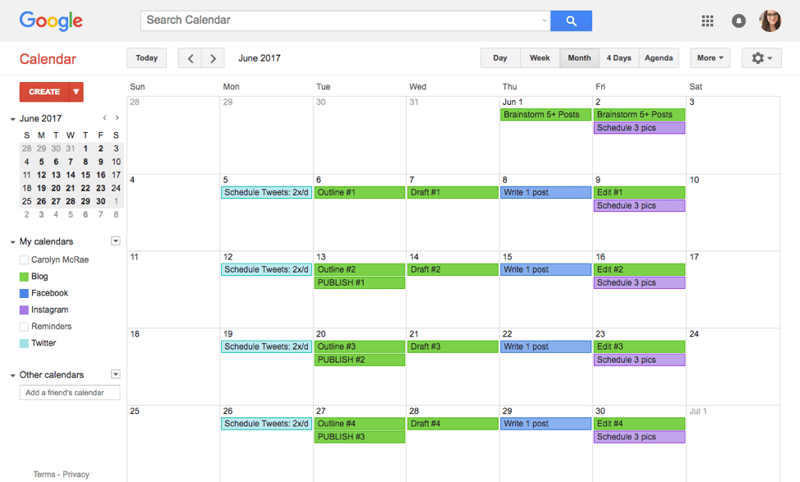Content Marketing Basics: Automate What You Can, Manage What You Can’t
Share this
Content marketing is all the rage. Many advisors who’ve been at it for a while regard content marketing as one of the biggest drivers of prospects. As a beginner, however, it can be daunting to know how or where start. There are many moving parts and it can feel overwhelming. Luckily there’s a little thing called automation. How exactly does that play a part? And how much of what needs to get done can be automated? Let’s find out.
It’s incredibly helpful and liberating to understand the basic tasks involved with content marketing. Some core tasks can be automated and some cannot. In this blog, I will walk you through this key overview and show you what a beginner’s content marketing “machine” could look like. My high-level advice when building a content marketing machine is: automate what you can, manage what you can’t, and leverage one-on-one coaching when you feel overwhelmed.
Parts of Content Marketing That Can and Can’t Be Automated
-
Posting on social media can be automated.
There are countless software options for pre-scheduling social media content (e.g. the ever-popular Hootsuite). Create an account, sync your social accounts, and spend a routine chunk of time writing and scheduling your posts for the week. The magic here is you can post content at, again, the optimal time without even being at your computer. -
Publishing an article on your blog at an optimal time can be automated.
Know the best time to engage readers? Well, you can leverage this information automatically. Most content management systems (e.g. Wordpress) allow you to publish your post on a scheduled date and time in the future. Don’t know what that “optimal” time is yet? Start experimenting now! Watch for a time that drives the most traffic to that post within the first six hours after publishing. -
Sharing new blog posts with your email list can be automated.
You can save about an hour of your time by setting up an automatic email to subscribers whenever you publish a new blog post; if you do this once a week or more, you’ll be saving at least half a day of work each month! Look for email automation features that are called “RSS.” This is available through most emailing systems (e.g. Mailchimp) and refers to an email that’s triggered based on new content to your blog. -
Nurturing new email sign-ups with premium content can be automated.
If one of your initiatives is to grow an email list (which not everyone needs to do), you’re already working hard to get new sign-ups. Once you have them, delight their inbox! Create an automated email workflow to automatically nurture sign-ups through the funnel. This is sometimes a paid feature, but if you try to imagine doing this manually, the value of paying for this “emailing assistant” becomes crystal clear.
-
Scoring leads can be automated.
This is an advanced marketer action, so if you’re just starting out, skip this one. However, if you have established a marketing machine that’s already generating numerous leads for your business, scoring those leads can save you tons of time and help avoid frustrations down the road. Scoring a lead simply entails assigning a numerical value to different actions a lead may take. For example, you can award 30 points for viewing the “services” page on your website, subtract 300 points for viewing a job posting on the “careers” page, add 100 points for attending a webinar, add 50 points for X number of social media engagements with you, and add 150 points for poking around your “pricing” page. Whatever you set up, do some math and decide what score a lead must have to earn your attention. When a lead reaches that score, do what you can to engage that person more directly. On the flip side, if you get a ton of inbound inquiries from leads who aren’t well-informed about your services or don’t fit your niche, you can save time by not scheduling in-person meetings, but rather trying to get to know them through remote efforts until you can evaluate their fit.
There are tools and resources available for getting these parts of your content marketing machine running. We will explore this more later. For now, let’s highlight a few major parts of content marketing that cannot, or should not, be automated.
-
Creating content (e.g. blog posts, podcasts, PDF downloads) cannot be automated.
There’s no way around it; an actual person must generate your content in order for it to be of any value to prospects. This is one marketing effort that cannot be automated. Take the time you dedicate to marketing and spend some of it on writing down your thoughts. Whether you then create the whole piece yourself or pass an outline off to an intern (or a ghostwriter!) to pull together, be sure your original thoughts are at the core of each piece. This instills your voice in the content, establishes consistency, and prevents that embarrassing moment when a prospect compliments a piece of “your” writing from a blog post you hardly recognize.
-
Pitching media outlets cannot be automated.
Getting press is an artful dance that no machine can master for you. If you want the local paper to write about an event you’re putting on or a relevant blogger to allow you to guest post, you must do the outreach yourself.
-
Writing social media posts can be partially automated.
You can automate some, but not all, of your social media content creation. If, for example, you regularly publish blog posts, you can set social media posts featuring that content to automatically publish to your social media channels using different software. There are even tools, like Meet Edgar and Revive Old Post (a WordPress plugin), that recycle your most popular posts in true “set it and forget it” fashion.
You cannot, however, automate the writing of all posts, and honestly, that’s probably a good thing. Having a mix of automatically and manually published posts helps your social media channels feel more genuine and less robotic. Block off a routine time in your calendar to compose posts manually; then let the rest be automated.
-
Replying to people who engage with your content can be automated, but here’s why you shouldn’t.
You technically can automate responses to engagement on social media. Some social channels, like Facebook, even offer native tools allowing you to do so. But if you have the capacity, you really should respond to people who engage with your social content yourself. Relying too heavily on automation to manage your social media accounts runs the risk of coming across as impersonal and even spammy, two words no brand ever wants to hear.
Here again you might consider a mix of automated and manual responses. For example, an automated response thanking new followers, if done correctly, may be a good option, especially if you don’t have the capacity to thank each new follower individually; a canned thank you using language that is “on brand” is better than no thank you at all.
Even if you do put an automation (e.g. an auto-responder thanking new followers) in place, walking away from your accounts is never a good idea; you still need to consistently check and monitor your social activity, and engage manually when necessary (e.g. direct messages, comments). If someone writes a comment on your recent article or replies to a tweet, a swift reply (within two hours is good) can mean the difference between occasionally converting commenters into prospects (yup, you can actually generate leads through social media through a little something called “social selling”) and never doing it. The best advice I can offer is turn on push notifications so you don’t have to manually check each platform; instead you’ll be notified when there’s activity. This allows you to engage in a timely fashion. Just think how good it feels when a thought-leader you follow replies to your comments. So good, right?
Although these pieces can’t be automated, there is a way to make them more manageable and easier to accomplish: use a content calendar.
Manage Your Manual Tasks with a Content Calendar
Content calendars are incredibly valuable. When you have one that works well for your firm, it will feel almost as though you have an actual marketing assistant. They keep you organized, productive, accountable, and moving toward your strategic vision.
Content calendars are simply a pre-planned schedule of all your content marketing efforts. It’s simple: plan your content marketing activities on a timeline and voilà, you have a content calendar!
As soon as advisors hear about content calendars, the next question I hear is: “Should I have one?” Ultimately, the answer to this question is easy: anyone who creates content will benefit. If you’re writing blogs or tweets or hosting a YouTube channel or starting a podcast or anything of the sort, a content calendar will serve you well. Plus, you’ll likely learn to love it.
Who Will Benefit Most from a Content Calendar?
The short answer? Everybody! But certain people really love content calendars. Let’s explore the five main archetypes that especially benefit from (and subsequently grow to love) using a content calendar.
The Under-Motivated
If you find yourself procrastinating, perhaps even going weeks without doing much for your content marketing, then you likely fall into the “under-motivated” category. People who are under-motivated need an external tool to help them hit their marketing stride. Content calendars for the under-motivated should have short laps (e.g. repeat every week) and only include very small, achievable tasks for the first two to three months. This way, you’ll set yourself up to develop a habit of marketing execution and achieve small victories that feel good.
The Busy Bee
Busy people have full calendars. If five-plus hours of your days are filled by meetings, then you likely fall into the “busy bee” category. Luckily, you’re already accustomed to following a calendar. All you need to do is integrate a content calendar into your already established work calendar and tackle those tasks the same way you do others. Treat them as equally important (you wouldn’t cancel a prospect meeting every week, would you?) and you’re set.
The Collaborator
Marketing often involves more than one person. Whether you’re working with other advisors at your firm or hiring outside contractors or summer interns, you fit into the “collaborator” category. The value of content calendars skyrockets as soon as a second or third person is brought into the picture. Calendars are an effective way to communicate both short-term action items and long-term strategies. Get everyone on the same page (pun intended) by creating a shared content calendar. You won’t believe the impact this will have on accountability and productivity.
The Competitor
Naturally competitive people do very well with content calendars. Crafted the right way, a content calendar can feel like a game. All you need to do is identify the players involved, set an objective, lay out a few rules, and define your resources. If this sounds fun to you, I highly suggest reading a couple of articles online about the basic elements of a game and turning your content marketing efforts into one.
How to Set Up a Basic Content Calendar (With Examples!)
Ideally, a content calendar encapsulates all activities on all platforms. When operating at this level, you know what you’re supposed to do today, what’s coming tomorrow, and what you accomplished last week. You don’t forget to do anything and everything runs like clockwork.
However, we don’t always live in an ideal world. Sometimes we have to start small and grow new habits slowly; let your content calendar grow with you!
If you’re creating your first content calendar, or a new one from scratch, I suggest choosing one outlet (e.g. your blog, Twitter, Facebook, events, podcast) and building a full plan for it before expanding. This will give you focus and reduce stress and you’ll feel the benefits sooner.
Start with your blog (or podcast).
If you have one, that is. If you don't, and don't have plans to launch major content of any kind, then start building your calendar with the platform you use the most often and/or that requires the most work.
Break everything down into bite-sized chunks. Common tasks include drafting, editing, and publishing a post, but there are other tasks too. For example, if you need a session to brainstorm ideas, add that to your calendar. If you want to make sure you don't forget to reflect back on your blog's performance metrics, include that too. Write everything down so you don't miss a step and can properly pace your work out.
The example calendar below assumes the goal of writing one post per week. This is a goal I recommend to every writer as a minimum. One post per week helps you establish a rhythm and remain committed to providing content to followers.

Next, add the thing you avoid most.
This really kicks your calendar into gear.
Let the calendar help you be a more diligent marketer. This whole setup would be too easy if you continued to ignore the tasks you don't like. But you're not in business to be mediocre; push yourself!
Take an honest look at your behavior and identify the content effort you've been neglecting. It's something you know you should do and believe could benefit your firm, but you avoid. What's the one action item you can do every week to make headway? Add that to your calendar now!
This sample calendar uses Facebook as an example. Perhaps you have a Facebook page that doesn't get enough attention. Commit to a simple action and put it on a day that doesn't have a “to-do” yet.

Then add other platforms you use.
You're on a roll! You have two platforms set up on the calendar and things have been running smoothly for a couple of weeks. You're ready for more and are realizing this content calendar is actually pretty darn helpful.
Now it's time to add other platforms to it: Twitter, Instagram, YouTube, forums, you name it.
At this point, every day should have at least one task. Time and again I've seen small business owners benefit greatly from executing on marketing every single day. Whether it's a 15-minute task or a two-hour writing session, your brain will adopt the new habit and daily marketing will become natural to you. If 3pm hits and your brain starts looking forward to the end of a workday, the thought, "Have I done my marketing today?" will pop into your head and you'll get to work.

Take it as far as you want!
Your content calendar can grow into whatever you want it to be. Depending on your habits and preferences, you can make your calendar simple or robust, high level or granular. Here are a few ideas for taking your content calendar to the next level:
- Set aside 10 minutes on Sunday evening or Monday morning to look at your content calendar and mentally prepare for the week ahead.
- Remind yourself to reflect back and look at metrics once in a while. I recommend every eight weeks.
- Get granular about your tasks (e.g. sharing new blog posts to Twitter).
- Add smaller, more personal efforts, like posting to LinkedIn or tweeting about your personal life on the weekends.

Now manual tasks are scheduled! Yes, you will hop in and manually follow this plan you’ve set for yourself, but it will require less thinking and less agony, benefits similar to full automation. Feel accomplished for doing this work upfront and understand that the calendar can (and likely will) evolve over time.
Use Software to Automate the Parts You Can
It’s time to look back on our earlier understanding about what can be automated and fill in the answer to “how?”
There are many options for marketing automation software and new solutions are developed all the time. A simple Google search for “marketing automation software SMB” or “marketing automation tools for advisors” will yield dozens of results. That said, there are a handful that have proven to be the most popular among financial advisors.
Let’s look at the big players. Financial Advisor Magazine mentioned four popular tools in their RIA Survey & Ranking 2017: Marketo, Eloqua, HubSpot, and Pardot. On top of this, polling of XYPN members revealed MailChimp, Constant Contact, and Broadridge are also worth checking out. Let’s explore some of these options.
All-in-One Solutions:
- Good for businesses of all sizes
- Highly customizable
- Some of the most detailed reports available
- Scores leads with nearly countless criteria
- CRM offers integration with Salesforce and Microsoft Dynamics
- Strong email design capabilities without the need for coding skills
- Includes landing page and social media tools
- Cons: pricey, steep learning curve for beginners, integrations often require technical support, customer service is known to be slow
- Good for businesses of all sizes
- Known for being one of the most intuitive platforms with strong customer service
- Lots of top-of-the-funnel tools and strategies, plus strong middle-of-the-funnel tactics
- Includes built-in CRM software, SEO, CMS, and social media tools
- ROI analyzing aligns marketing and sales, allowing for smarter marketing investments
- Reports are easy to build and read
- Very strong, easy-to-use email automation and workflow management
- Cons: pricing is complex and requires speaking with a representative, limited customization options beyond what an average user would want
- Should be reserved for larger firms; enterprise-style software solution is powerful, but requires a big budget and technical know-how
- Robust emailing capabilities
- Drag-and-drop landing page design
- Native integrations with Salesforce, Microsoft Dynamics and Oracle/Siebel CRM On Demand
- Social media tool helps feature social content on your website and offers comprehensive measurement of all social activity
- Reports are customizable and can help measure quality of prospects
- Cons: too pricey for small businesses, requires technical resources to properly use, steep learning curve
- Good for midsize to large firms
- One of the more affordable choices
- Many middle-of-the-funnel capabilities for managing visitors once they’ve found you
- Landing pages can adjust based on a lead’s search term and other conditions
- Strong integrations with Google Analytics, AdWords, and most CRM platforms
- ROI of paid ads can be computed
- “Lifecycle Stage” analysis gives a breakdown of your sales pipeline and measures funnel velocity
- Cons: built with B2B marketing in mind, limited SEO functionality, user interface and processes are a bit complex, no event management automation
It’s Time to Start, Not Panic
I know this was a lot of information to take in, but you have time now to execute. It is my intention to give you this resource as a guide and to show you what a beginner’s content marketing “machine” could look like. Now it’s time to chip away at it. Bookmark this page in your browser and come back to it each day (or week) until you feel like less of a beginner and more of a boss.
As with most things in business, there is often more to discuss than can be covered in a single blog post. If you are interested in one-on-one marketing help from me and are a member of XYPN, be sure to check out my marketing coaching!
 About the Author
About the Author
Carolyn McRae is a professional marketer with more than five years of experience helping small businesses reach their growth goals. Her approach to marketing is both creative and analytical; helping people achieve a creative flow that’s unique and exciting, while using tracking and metrics to learn what actually works for their business. Today she’s a full-time marketer based in Boston, feeling honored and excited to step into the XY Planning Network as a Marketing Coach. Outside of work she enjoys volunteering with elderly, making videos, and traveling with her friends and family.
Share this
- Running Your RIA Efficiently: Outsourcing Bookkeeping with XYPN Books
- Road to Launch with XYPN Member Alan Skillern, CFP®, MBA
- Coaching for Better Time Management: Prioritizing Organic Growth in Your Daily Routine
- Boost Your Financial Advisory Practice: SEO Strategies and CRM Optimization for Sales Success
- Advisor Blog (693)
- Financial Advisors (221)
- Growing an RIA (99)
- Digital Marketing (87)
- Marketing (84)
- Community (81)
- Start an RIA (76)
- Business Development (72)
- Coaching (72)
- Running an RIA (70)
- Compliance (69)
- Client Acquisition (65)
- Technology (64)
- XYPN LIVE (59)
- Entrepreneurship (57)
- Sales (49)
- Practice Management (44)
- Client Engagement (41)
- Bookkeeping (38)
- XYPN Books (38)
- Investment Management (37)
- Fee-only advisor (36)
- Lifestyle, Family, & Personal Finance (31)
- Employee Engagement (30)
- Client Services (25)
- Financial Education & Resources (25)
- Journey Makers (21)
- Market Trends (21)
- Process (14)
- Niche (11)
- SEO (9)
- Scaling an RIA (9)
- Career Change (8)
- Transitioning Your Business (7)
- Partnership (6)
- Transitioning To Fee-Only (4)
- Social Media (3)
- Transitioning Clients (3)
- Emerald (2)
- Persona (2)
- RIA (2)
- Onboarding (1)
- Sapphire (1)
Subscribe by email
You May Also Like
These Related Stories

Content Marketing: An Intro for Financial Advisors
Nov 19, 2015
4 min read

The 5-Step Blueprint to Effective Content Marketing
Oct 10, 2022
8 min read





